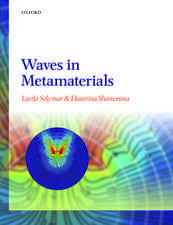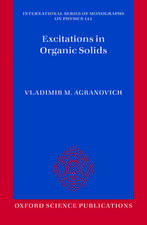Physics of New Materials: Springer Series in Materials Science, cartea 27
Editat de Francisco E. Fujita Contribuţii de R. W. Cahn, F.E. Fujita, H. Fujita, U. Gonser, J. Kanamori, K. Motizuki, R.W. Siegel, N. Sumida, K. Suzuki, N. Suzukien Limba Engleză Paperback – 17 mar 2012
Din seria Springer Series in Materials Science
- 18%
 Preț: 1820.22 lei
Preț: 1820.22 lei - 18%
 Preț: 776.09 lei
Preț: 776.09 lei - 24%
 Preț: 689.69 lei
Preț: 689.69 lei - 18%
 Preț: 968.96 lei
Preț: 968.96 lei - 20%
 Preț: 568.95 lei
Preț: 568.95 lei - 18%
 Preț: 953.65 lei
Preț: 953.65 lei - 18%
 Preț: 902.36 lei
Preț: 902.36 lei - 18%
 Preț: 953.65 lei
Preț: 953.65 lei - 20%
 Preț: 948.42 lei
Preț: 948.42 lei - 18%
 Preț: 1143.07 lei
Preț: 1143.07 lei - 18%
 Preț: 1111.53 lei
Preț: 1111.53 lei - 18%
 Preț: 1103.62 lei
Preț: 1103.62 lei - 18%
 Preț: 1225.94 lei
Preț: 1225.94 lei -
 Preț: 473.91 lei
Preț: 473.91 lei - 18%
 Preț: 782.42 lei
Preț: 782.42 lei -
 Preț: 433.47 lei
Preț: 433.47 lei - 18%
 Preț: 1116.40 lei
Preț: 1116.40 lei - 18%
 Preț: 946.24 lei
Preț: 946.24 lei - 18%
 Preț: 945.20 lei
Preț: 945.20 lei - 18%
 Preț: 1114.21 lei
Preț: 1114.21 lei - 15%
 Preț: 641.20 lei
Preț: 641.20 lei - 18%
 Preț: 958.56 lei
Preț: 958.56 lei - 18%
 Preț: 1224.36 lei
Preț: 1224.36 lei - 15%
 Preț: 644.82 lei
Preț: 644.82 lei - 24%
 Preț: 833.45 lei
Preț: 833.45 lei - 24%
 Preț: 1060.36 lei
Preț: 1060.36 lei - 18%
 Preț: 964.10 lei
Preț: 964.10 lei - 18%
 Preț: 1224.36 lei
Preț: 1224.36 lei - 18%
 Preț: 1221.20 lei
Preț: 1221.20 lei - 18%
 Preț: 946.87 lei
Preț: 946.87 lei - 18%
 Preț: 1836.92 lei
Preț: 1836.92 lei - 15%
 Preț: 643.34 lei
Preț: 643.34 lei - 18%
 Preț: 1246.32 lei
Preț: 1246.32 lei - 18%
 Preț: 956.81 lei
Preț: 956.81 lei - 18%
 Preț: 953.52 lei
Preț: 953.52 lei - 15%
 Preț: 637.59 lei
Preț: 637.59 lei
Preț: 390.46 lei
Nou
Puncte Express: 586
Preț estimativ în valută:
74.74€ • 81.21$ • 62.82£
74.74€ • 81.21$ • 62.82£
Carte tipărită la comandă
Livrare economică 21 aprilie-05 mai
Preluare comenzi: 021 569.72.76
Specificații
ISBN-13: 9783642468643
ISBN-10: 3642468640
Pagini: 336
Ilustrații: XII, 318 p.
Dimensiuni: 155 x 235 x 18 mm
Greutate: 0.47 kg
Ediția:Softcover reprint of the original 2nd ed. 1998
Editura: Springer Berlin, Heidelberg
Colecția Springer
Seria Springer Series in Materials Science
Locul publicării:Berlin, Heidelberg, Germany
ISBN-10: 3642468640
Pagini: 336
Ilustrații: XII, 318 p.
Dimensiuni: 155 x 235 x 18 mm
Greutate: 0.47 kg
Ediția:Softcover reprint of the original 2nd ed. 1998
Editura: Springer Berlin, Heidelberg
Colecția Springer
Seria Springer Series in Materials Science
Locul publicării:Berlin, Heidelberg, Germany
Public țintă
ResearchCuprins
1 Introductory Survey.- 1.1 New Materials and Necessity of Physics in their Development.- 1.2 Examples of Physics of New Materials.- 1.3 Brief Introduction of the Contents.- References.- 2 Electronic Structure and Properties of Transition Metal Systems.- 2.1 Background.- 2.2 Basic Concepts of Electronic Structure Calculation of Transition Metal Systems.- 2.3 Bulk and Defect Electronic Structure of Ferromagnetic Transition Metal Systems.- 2.4 Structural Problems.- 2.5 Limitation of the One Electron Theory.- 2.6 Future Development.- References.- 3 Structure Characterization of Solid-State Amorphized Materials by X-Ray and Neutron Diffraction.- 3.1 New Generation Scattering Experiments.- 3.2 Mechanical Alloying and Mechanical Disordering.- 3.3 Medium-Range Structure of Metallic Amorphous Alloys.- 3.4 Conversion of Organic Polymers to Amorphous Ceramics.- 3.5 Hydrogen-Induced Amorphization.- References.- 4 Nanophase Materials: Synthesis, Structure, and Properties.- 4.1 Background.- 4.2 Synthesis and Processing.- 4.3 Structure and Stability.- 4.4 Properties.- 4.5 Future Directions.- References.- 5 Intercalation Compounds of Transition-Metal Dichalcogenides.- 5.1 Background.- 5.2 Electronic Band Structures of 3d Transition-Metal Intercalated Compounds of 1T—Type TiS2.- 5.3 Bonding Nature in MxTiS2 (M: 3d Transition-Metal).- 5.4 Electronic Band Structures of AgxTiS2.- 5.5 2H—Type TX2 (T = Nb, Ta; X = S, Se) Intercalated with Transition-Metals.- 5.6 Discussion.- References.- 6 Structural Phase Transformation.- 6.1 General View.- 6.2 A Phenomenological Theory and a Statistical View of Phase Transition.- 6.3 Martensitic Transformation of Metals and Alloys.- 6.4 Shape Memory Effect and Premartensitic Phenomena.- 6.5 Martensite and Other Problems in Ceramics.- 6.6Conclusions.- References.- 7 The Place of Atomic Order in the Physics of Solids and in Metallurgy.- 7.1 Historical Development.- 7.2 Antiphase Domains.- 7.3 Theory of Ordering.- 7.4 Special Experimental Methods.- 7.5 Ordering Kinetics and Disorder Trapping.- 7.6 Computer Simulation of Ordering and Disordering and Related Features.- 7.7 Ordering and Disordering at Free Surfaces, Interfaces and at Antiphase Domain Boundaries.- 7.8 Magnetic and Atomic Order.- 7.9 Ordering in Semiconductors and Other Non-Metals.- 7.10 Order and Mechanical Properties.- 7.11 Conclusion.- 7.12 Addendum.- References.- 8 Usefulness of Electron Microscopy.- 8.1 Background.- 8.2 Principles of Image Formation.- 8.3 High-Resolution Electron Microscopy.- 8.4 Indispensable Applications of HVEMy.- 8.5 New Research Fields by HVEMy “Micro-Laboratory”.- 8.6 Conclusions.- References.- 9 Mössbauer Spectroscopy in Materials Science.- 9.1 Historical Remarks.- 9.2 Principles.- 9.3 Hyperfine Interaction.- 9.4 Polarization and Thickness Effects.- 9.5 Phase Analysis.- 9.6 Cu-Fe System.- 9.7 Precision Phase Analysis.- 9.8 Amorphous Metals, General.- 9.9 Amorphous Metals, Experimental.- 9.10 Nanocrystalline Materials.- 9.11 Crystallization.- 9.12 Simultaneous Triple-Radiation Mössbauer Spectroscopy (STRMS).- 9.13 Quo Vadis?.- References.- 10 Further Progress.- 10.1 Eelectronic Structure and Magnetism of Transition Metal Systems.- 10.2 Structure Characterization of Solid-State Amorphized Materials by X-Ray and Neutron Diffraction.- 10.3 Recent Progress in Nanophase Materials.- 10.4 Further Progress in the Theory of Intercalation Compounds.- 10.5 Various New-type Carbon Materials.- 10.6 New Findings in Ordered Structures.- 10.7 Recent Developments in High-Resolution and High-Voltage Electron Microscopy.- 10.8New Directions in Mössbauer Spectroscopy.
Caracteristici
This edition has been enlarged by an additional chapter on most recent developments















